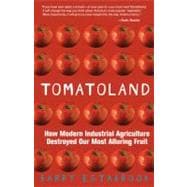
Note: Supplemental materials are not guaranteed with Rental or Used book purchases.
Purchase Benefits
What is included with this book?
| Acknowledgments | p. xi |
| Introduction: On the Tomato Trail | p. xiii |
| Roots | p. 1 |
| A Tomato Grows in Florida | p. 17 |
| Chemical Warfare | p. 35 |
| From the Hands of a Slave | p. 73 |
| An Unfair Fight | p. 97 |
| A Penny per Pound | p. 121 |
| Matters of Taste | p. 139 |
| Building a Better Tomato | p. 153 |
| Tomatoman | p. 169 |
| Wild Things | p. 185 |
| Afterword: New World, Old Challenge | p. 189 |
| Notes | p. 198 |
| Bibliography | p. 212 |
| Index | p. 214 |
| Table of Contents provided by Ingram. All Rights Reserved. |
The New copy of this book will include any supplemental materials advertised. Please check the title of the book to determine if it should include any access cards, study guides, lab manuals, CDs, etc.
The Used, Rental and eBook copies of this book are not guaranteed to include any supplemental materials. Typically, only the book itself is included. This is true even if the title states it includes any access cards, study guides, lab manuals, CDs, etc.